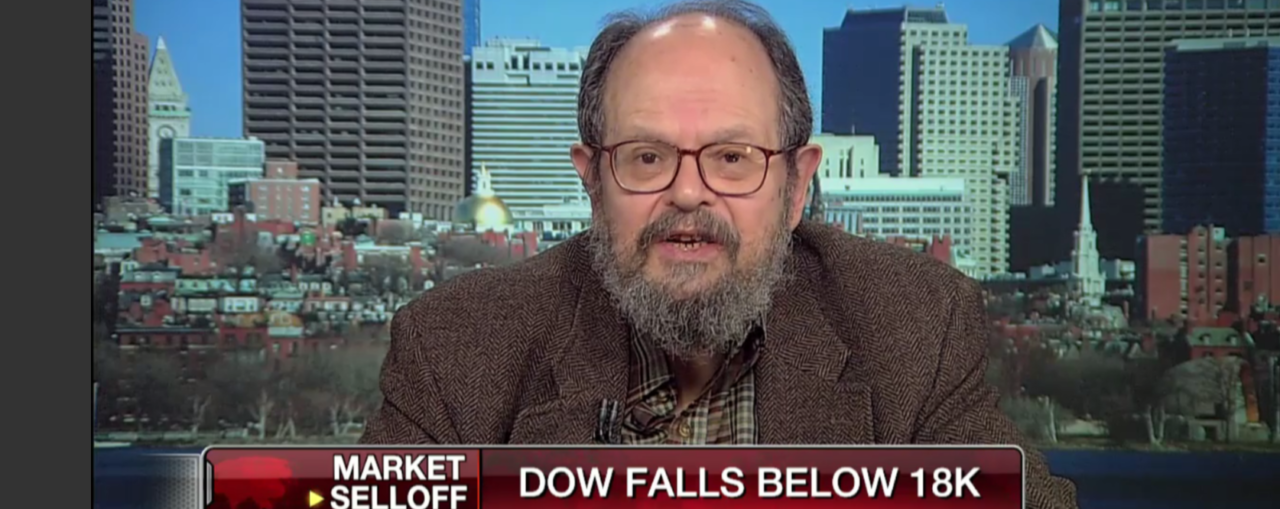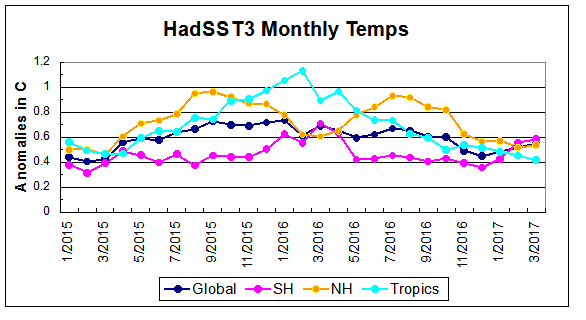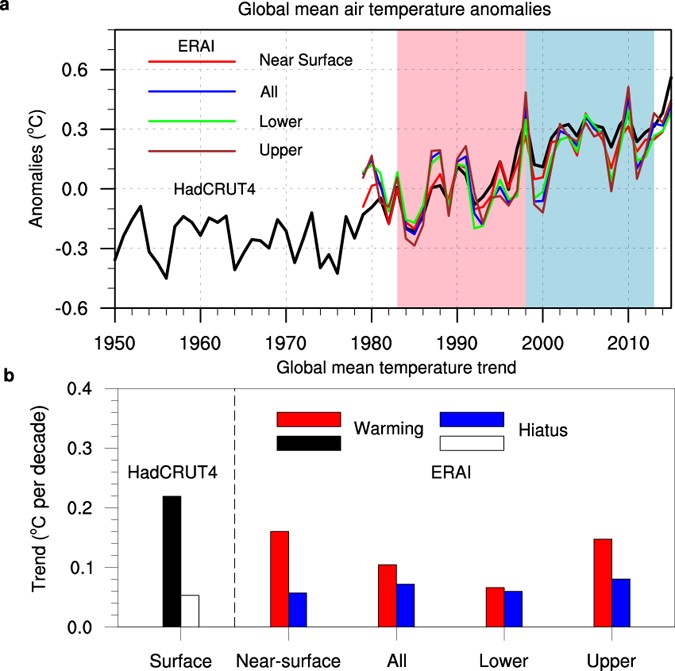Scientists ‘More Confident Than Ever’ In Global Warming After Studying The Lack Of It For 15 Years
By Michael Bastasch
A new study examining explanations for the 10- to 15-year “hiatus” in global warming has scientists “more confident than ever that human influence is dominant in long-term warming.”
“In a time coinciding with high-level political negotiations on preventing climate change, skeptical media and politicians were using the apparent lack of warming to downplay the importance of climate change,” researchers with the Institute for Atmospheric and Climate Science (IACS) in Switzerland wrote in a study published Thursday in the journal Nature.
“A few years of additional data are unlikely to overturn the vast body of evidence that supports anthropogenic climate change,” reads the study, adding the recent El Nino and new data have them “more confident than ever that human influence is dominant” in global warming.
IACS’s study looked at different explanations for the “hiatus” in global warming, which the study defined as the 10 or 15 years after 1998, ultimately to put to rest arguments by skeptics the lack of warming during this time cut into theories of catastrophic warming.
Another Arctic ice panic ends as world temperatures plummet
Inevitably, when even satellite temperatures were showing 2016 as “the hottest year on record”, we were going to be told last winter that the Arctic ice was at its lowest extent ever. Sure enough, before Christmas, a report from the US National Oceanic and Atmospheric Administration was greeted with such headlines as “Hottest Arctic on record triggers massive ice melt”. In March we had the BBC trumpeting another study that blamed vanishing Arctic ice as the cause of weather which led to the worst-ever smog in Beijing, warning that it “could even threaten the Beijing Winter Olympics in 2022”.
But last week we were brought back to earth by the Danish Meteorological Institute (DMI), as charted by our friend Paul Homewood on his blog Notalotofpeopleknowthat, with the news that ever since December temperatures in the Arctic have consistently been lower than minus 20 C. In April the extent of Arctic sea ice was back to where it was in April 13 years ago. Furthermore, whereas in 2008 most of the ice was extremely thin, this year most has been at least two metres thick. The Greenland ice cap last winter increased in volume faster than at any time for years.
As for those record temperatures brought in 2016 by an exceptionally strong El Niño, the satellites now show that in recent months global temperatures have plummeted by more that 0.6 degrees: just as happened 17 years ago after a similarly strong El Niño had also made 1998 the “hottest year on record”.
This means the global temperature trend has now shown no further warming for 19 years. But the BBC won’t be telling us any of this. And we are still stuck with that insanely damaging Climate Change Act, which in this election will scarcely get a mention.
Full post
…NEW STUDY CONFIRMS: THE WARMING ‘PAUSE’ IS REAL AND REVEALING
A new paper has been published in the Analysis section of Nature called Reconciling controversies about the ‘global warming hiatus.’ It confirms that the ‘hiatus’ or ‘pause’ is real. It is also rather revealing.
It attempts to explain the ‘Pause’ by looking into what is known about climate variability. They say that four years after the release of the IPCC AR5 report, which contained much about the ‘hiatus’ it is time to see what can be learned.
One could be a little sarcastic in saying why would Nature devote seven of its desirable pages to an event that some vehemently say never existed and maintain its existence has been disproved long ago. Now, however, as the El Nino spike of the past few years levels off, analysing the ‘pause’ seems to be coming back into fashion.
The authors of this recent paper delicately tread a line between the two opposing camps saying, on the one hand, that both sides have a point and their particular methods of analysis are understandable. But on the other hand they make it clear that there is a real event that needs studying.
As someone who has paid close attention to the ‘pause’ for almost a decade I am perhaps more attentive than most when it comes to a retelling of the history of the idea and the observations.
The authors say the pause started with claims from outside the scientific community. Well, yes and no. It was tentatively suggested in 2006 and 2007 by climate sceptics many of whom were experienced scientists and quite capable of reading a graph and calculating statistics. A decade after it was raised, every time the ‘pause’ is debated it is a tribute to those who first noticed it and faced harsh criticism. It was the sceptics who noticed the ‘pause,’ and in doing so made a valuable contribution to science. For years it was only analysed and discussed on the blogosphere before journals took notice.
There is nothing new in their recent paper or that hasn’t been discussed by the GWPF. Perhaps that will give pause for thought for some who see battle lines drawn between pause supporters (sceptics) and pause busters (scientists).
What the authors miss, with their three definitions of the pause, is a simple fact we have often pointed out. Look at HadCRUT4 from …
MIT Climate Scientist Dr. Richard Lindzen: Believing CO2 controls the climate ‘is pretty close to believing in magic’

Richard Lindzen is the Alfred P. Sloan Professor of Atmospheric Sciences, Emeritus at Massachusetts Institute of Technology.

MIT atmospheric science professor Richard Lindzen suggests that many claims regarding climate change are exaggerated and unnecessarily alarmist.
Introduction:
For over 30 years, I have been giving talks on the science of climate change. When, however, I speak to a non-expert audience, and attempt to explain such matters as climate sensitivity, the relation of global mean temperature anomaly to extreme weather, that warming has decreased profoundly for the past 18 years, etc., it is obvious that the audience’s eyes are glazing over. Although I have presented evidence as to why the issue is not a catastrophe and may likely be beneficial, the response is puzzlement. I am typically asked how this is possible. After all, 97% of scientists agree, several of the hottest years on record have occurred during the past 18 years, all sorts of extremes have become more common, polar bears are disappearing, as is arctic ice, etc. In brief, there is overwhelming evidence of warming, etc. I tended to be surprised that anyone could get away with such sophistry or even downright dishonesty, but it is, unfortunately, the case that this was not evident to many of my listeners. I will try in this brief article to explain why such claims are, in fact, evidence of the dishonesty of the alarmist position.
The 97% meme:
This claim is actually a come-down from the 1988 claim on the cover of Newsweek that all scientists agree. In either case, the claim is meant to satisfy the non-expert that he or she has no need to understand the science. Mere agreement with the 97% will indicate that one is a supporter of science and superior to anyone denying disaster. This actually satisfies a psychological need for many people. The claim is made by a number of individuals and there are a number of ways in which the claim is presented. A thorough debunking has been given in the Wall Street Journal by Bast and Spencer. One of the dodges is to poll scientists as to whether they agree that CO2 levels in the atmosphere have increased, that the Earth has been warming (albeit only a little) and that man has played some part. This is, indeed, something almost all of us can agree on, but which has no …
GLOBAL TEMPERATURES PLUNGE NEARLY 1 DEGREE F IN APRIL
http://www.thegwpf.com/global-temperatures-plunge-0-5-celsius-in-april/
GLOBAL TEMPERATURES PLUNGE 0.5° CELSIUS IN APRIL (0.9° Fahrenheit drop)
Global temperatures have dropped 0.5° Celsius in April. In the Northern Hemisphere they plunged a massive 1°C . As the record 2015/16 El Nino levels off, the global warming hiatus is back with a vengeance.

Global Temperatures Drop To Pre-El Nino Levels
Despite NOAA’s Denial, A Growing Number Of Studies Confirm the Global Warming Hiatus
Despite widespread denial among climate activists, a growing number of scientific research papers in recent months have confirmed the global warming hiatus, trying to explain its possible reasons (for the latest studies see here, here and here). The latest study claims that the Southern Ocean played a critical role in the global warming slowdown.
New Climate Study Calls EPA’s Labeling Of CO2 A Pollutant ‘Totally False’
A new study published by seasoned researchers takes aim at the heart of the Environmental Protection Agency’s (EPA) authority to issue regulations to curb carbon dioxide emissions.
The study claims to have “proven that it is all but certain that EPA’s basic claim that CO2 is a pollutant is totally false,” according to a press statement put out by Drs. Jim Wallace, John Christy and Joe D’Aleo.
Wallace, Christy and D’Aleo — a statistician, a climatologist and meteorologist, respectively — released a study claiming to invalidate EPA’s 2009 endangerment finding, which allowed the agency to regulate CO2 as a pollutant.
“This research failed to find that the steadily rising atmospheric CO2 concentrations have had a statistically significant impact on any of the 14 temperature data sets that were analyzed,” the authors say in the release for the second edition of their peer-reviewed work.
“Moreover, these research results clearly demonstrate that once the solar, volcanic and oceanic activity, that is, natural factor, impacts on temperature data are accounted for, there is no ‘record setting’ warming to be concerned about,” the researchers say. “In fact, there is no natural factor adjusted warming at all.”
The study is intended to bolster a petition Wallace and D’Aleo filed with EPA as part of the Household Electricity Consumers Council (CHECC), asking the agency to reconsider its endangerment finding.
The libertarian Competitive Enterprise Institute (CEI) also filed a petition with EPA to reconsider the endangerment finding. The Trump administration has not indicated whether or not they will reconsider the Obama-era finding. Any challenge would be met with legal action from environmental activists.…
Believe It! Global Warming Hiatus Real, Chinese And Japanese Scientists Affirm
Slowdown: The braked warming of the last one and a half decades and its reasons
By Dr. Sebastian Lüning und Prof. Fritz Vahrenhholt
(German text translated by P Gosselin)
Stefan Rahmstorf is against the notion of a warming hiatus. In his eyes it doesn’t exist. Instead he prefers to live in his Rahmstorfian world, where every thing is the way it’s supposed to be: warming is galloping along. It’s a strange parallel world that has nothing to do with reality.
The rest of the scientific community, fortunately, see things somewhat more realistically and are busily publishing papers on the reasons for the hiatus or slowdown. The Institute for Atmospheric Physics of the Chinese Academy of Sciences has even issued a press release on the subject:
New Study Reveals the Atmospheric Footprint of the Global Warming Hiatus
The increasing rate of the global mean surface temperature was reduced from 1998 to 2013, known as the global warming hiatus or pause. Great efforts have been devoted to the understanding of the cause. The proposed mechanisms include the internal variability of the coupled ocean-atmosphere system, the ocean heat uptake and redistribution, among many others. However, the atmospheric footprint of the recent warming hiatus has been less concerned. Both the dynamical and physical processes remain unclear.
In a recent paper published in Scientific Report, LIU Bo and ZHOU Tianjun from the Institute of Atmospheric Physics, Chinese Academy of Sciences have investigated the atmospheric anomalous features during the global warming hiatus period (1998-2013). They show evidences that the global mean tropospheric temperature also experienced a hiatus or pause (Fig. 1). To understand the physical processes that dominate the warming hiatus, they decomposed the total temperature trends into components due to processes related to surface albedo, water vapor, cloud, surface turbulent fluxes and atmospheric dynamics. The results demonstrated that the hiatus of near surface temperature warming trend is dominated by the decreasing surface latent heat flux compared with the preceding warming period, while the hiatus of upper tropospheric temperature is dominated by the cloud-related processes. Further analysis indicated that atmospheric dynamics are coupled with surface turbulent heat fluxes over lower troposphere and coupled with cloud processes over upper troposphere.
Figure 1. (a) Global mean temperature anomalies from 1950 to 2015 and (b) linear trends of global mean temperature for near surface (i.e. the lowest atmospheric layer), and
Analysis: U.S. Temperature Data Tampering – Worse Than It Seems
Most people assume that temperature graphs from NOAA and NASA are generated by averaging thermometer data and honestly reporting their findings. This belief is based on a blind belief in authority, rather than evidence. NOAA publishes two US temperature data sets – raw and final.
Source: US Temperature Data Tampering – Worse Than It Seems…
STUDY: Temperature Data Isn’t Accurate Enough To Find The Cause Of The ‘Hiatus’ In Global Warming
By MICHAEL BASTASCH
New research found there was, in fact, a nearly 15-year “hiatus” in global warming in the early part of the 21st Century, suggesting it could have been caused by natural variability in the atmosphere’s energy balance.
What’s more is climate scientists with Germany’s Max Planck Institute found there’s too much uncertainty in observational data to determine the true cause of the “hiatus” in warming.
Scientists argue that “unless the uncertainty of observational estimates can be considerably reduced, the true origin of the recent hiatus may never be determined.”
“That’s an important sentence, because it demonstrates that despite many claims to the contrary, CO2 induced forcing of the planetary temperature is not the control knob, and natural variability remains in force,” veteran meteorologist Anthony Watts wrote of the Max Planck study on his blog Watts Up With That.
Max Planck scientists found hiatuses in global warming can be caused by relatively small changes in ocean energy balance, which can originate from the top of the atmosphere or the ocean.
“This is the true dilemma at the heart of the hiatus debate: the variability in ocean heat content alone has no power to explain the hiatus, and the measure that can—the surface-layer flux divergence—is dwarfed by observational uncertainty,” researchers wrote in their study, led by scientist Christopher Hedemann.
For years, scientists have debated the existence of the “hiatus” in global warming — a period from 1998 to 2012 with little to no statistically significant warming.…
New Paper: N. Hemisphere Temps Rose 4–5°C Within ‘A Few Decades’ 14,700 Years Ago – 40 Times Faster Than Today’s Rates
Temperatures, Sea Levels ‘Naturally’ Rise
30 – 40 Times Faster Than Today’s Rates
Modern Temperatures Only Rising 0.05°C/Decade
Since 1850, CO2 concentrations have risen from 285 ppm to 400 ppm. During these ~165 years, the IPCC has concluded that surface temperatures have warmed by 0.78°C. This is a warming rate of only 0.05°C per decade for 1850-2012 — which happens to be the same rate of warming over the 1998-2012 period.
IPCC AR5 (2013): “The globally averaged combined land and ocean surface temperature data as calculated by a linear trend, show a warming of 0.85°C over the period 1880 to 2012, when multiple independently produced datasets exist. The total increase between the average of the 1850–1900 period and the 2003–2012 period is 0.78 °C, based on the single longest dataset available 4 (see Figure SPM.1). … [T]he rate of warming over the past 15 years (1998–2012; 0.05 °C per decade), which begins with a strong El Niño, is smaller than the rate calculated since 1951 (1951–2012; 0.12 °C per decade).”
Modern Sea Levels Only Rising 0.17 Of A Meter/Century
IPCC AR5 (2013): “[T]he rate of global averaged sea level rise was 1.7 mm yr between 1901 and 2010“
Historical Hemispheric Temperatures Rose 2.0°C/Decade
According to a new paper, the Bølling Warming event 14,700 years ago raised the surface temperature for the entire Northern Hemisphere by 4 to 5°C within a few decades. This is a hemispheric warming rate of approximately 2.0°C per decade, which is 40 times faster than the 0.05 °C per decade global warming rate since 1850 (and 1998).
Historical Sea Levels Rose 5.3 Meters/Century
Central Greenland’s surface temperatures rose by as much as 12°C during this time frame (14,700 years ago to 14,500 years ago). Consequently, glaciers and ice sheets disintegrated rapidly and sea levels rose by about 18 meters (“12-22 m”) in 340 years. An 18 m rise in 340 years is the equivalent of 5.3 meters per century, which is more than 30 times faster than the rate of sea level change (0.17 m per century) between 1901 and 2010.



